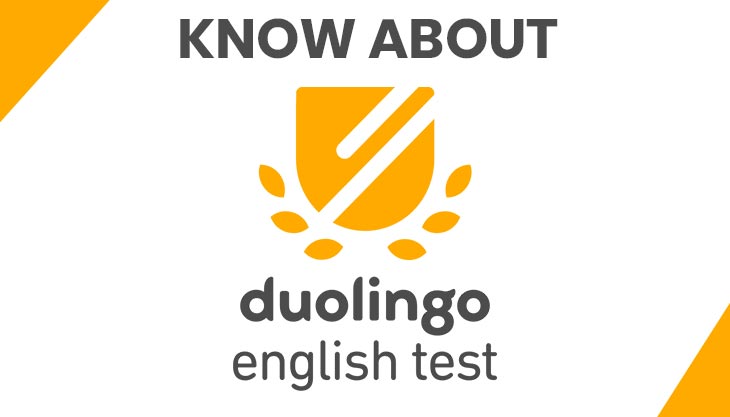For all you Overseas Education aspirants – here is a piece of great news!
Duolingo, best known for its app that teaches a range of foreign languages, recently launched an English proficiency test.
While initially not accepted by universities worldwide, or accepted only as a supplement to the more formal tests like IELTS and PTE…owing to the Covid-19 pandemic and closure of testing centres across several countries, many universities are now accepting the Duolingo English Test as fulfilling English language requirements for international aspirants.
Which means that if you have suffered a cancelation of your IELTS and PTE English test, and do not know what to do with deadlines fast approaching – you now have a solution!
The Hurray Overseas Education team has compiled a list of information on this test.
In this blogpost, we are going to break down the Duolingo test and tell you all you need to know. Happy reading!
Quick specs
-
How does it work?
Like all other major language tests, the Duolingo test tests your major language skills or LSRW – i.e. Listening, Speaking, Reading and Writing.
-
Where can you take it?
Unlike the traditional tests, including IELTS and PTE, which have to be taken at designated test centres – the Duolingo test can be taken at home! This is of course one of its biggest selling-points, in the case of the current Covid-19 scenario.
-
How much does it cost?
Another major selling-point: Duolingo is as low-cost as it gets!
At just 49 USD, or approximately 3800 INR at current rates of exchange, Duolingo is extremely affordable, in comparison to the other tests which all cost upwards of 200 USD.
In-depth information
Requirements
To take the test, you would require the following:
-
Your passport, driver's license or government ID
-
A quiet, well-lit room
-
A computer with a reliable internet connection, a supported browser, a front facing camera, speakers and a microphone
Rules
-
You must be seated alone. There can be no other person in the room.
-
You are not allowed to take any notes.
-
You are not allowed to deviate from the browser tab/window.
-
Your front-facing camera will be switched on and you will be recorded over the duration of your test. The recorded video will be viewed by proctors, or exam supervisors, and will be reviewed by 2 independent reviewers – meaning that any deviation from the rules, or any red flags like an additional face or background noise, will be seen and can result in disqualification.
-
You can attempt the test up to two times within a 30-month period. If a test fails due to a technical glitch, it will not be counted as an attempt – you would still have 2 attempts remaining.
How do you register for a test?
The procedure could not be simpler!
All you need to do is go to the main website: Duolingo English Test and sign up to create your account.
You will see an option for a 15-minute practice test, which you can take as many times as you like.
When you’re ready, pay the 49 USD and unlock the test. You can then take the test any time that you want – no fixed appointment required!
Test structure
-
Duration
The total duration of the test will be of 60 minutes.
The time is broken down to include
-
5 minutes: introduction and test rules and requirements. At this time, you will be required to fill in your details as per your proof of identity. Ensure that you keep everything that you would require immediately handy.
-
45 minutes: scored section, consisting of the questions you will be answering for your test.
-
10 minutes: unscored video interview and writing sample (see below for the details)
In terms of individual question time limits, each question has a different one, depending on the difficulty level/required time for completion – but rest assured, you will have plenty of time to finish.
-
Adaptive format
The Duolingo test in unique among English tests in this regard.
As per the adaptive format, the difficulty level of the questions will be adapted to your performance. This means that if you get a question correct, the next one will be of a higher difficulty level; and if you get it wrong, you will get an easier question.
What does this mean? Essentially, that the test is intelligent enough to pinpoint your language skills in a short period of time.
Note: unlike in other tests, the different tasks for the 4 LSRW skills will be all jumbled up.
-
Scoring
You will receive a score between 10 to 160.
|
Score range |
Proficiency level |
|
10-55 |
Low proficiency – has basic vocabulary and limited range of expression, resulting in lower ability to comprehend/communicate |
|
60-85 |
Low intermediate – has sufficient vocabulary and means of expression, and can comprehend/communicate effectively in familiar contexts |
|
90-115 |
Intermediate – has good vocabulary and means of expression, can comprehend/communicate effectively in regards to unfamiliar topics as well |
|
120-160 |
High proficiency – has excellent vocabulary and means of expression, can understand language complexity, abstraction and idiom, can communicate effectively |
-
Types of questions
The following are the types of questions you can expect during the scored section of your test.
|
Skill tested |
Types of questions |
|
Listening |
Select words that belong to the English language: you will listen to a range of words, some of which will be actual English words, while others will be non-sensical. Your task is to select all the words that are correct.
Type out a recorded sentence: a recording of a short sentence will play. Your task is to type it out exactly as you hear it. You will be given 2 chances to listen to the recording again, if required. |
|
Speaking |
Label the object: on the screen, you will see an image of an object. Your task is to name the object, speaking into the microphone.
Speak aloud a written sentence: on the screen, you will see a sentence. Your task is to speak it aloud into the microphone.
Speak on a short topic: on the screen, you will see a short topic related to your personal experience or an unknown topic. You will be given a few talking points to cover, as well as 30 seconds prep-time. Your task is to speak on the given topic, covering all the points, within the given time limit. |
|
Reading |
Select words that belong to the English language: on the screen, you will see a list of words – some of which will b actual English words while others will be non-sensical. Your task is to select all the words that are correct.
Complete the passage: on the screen you will see a passage, with several incomplete words. Your task is to complete each word, keeping in mind the context and the number of letters in each word. |
|
Writing |
Describe the given image: on the screen, you will see an image of something or the other. Your task is to describe everything that you see in the image, in 2 or more sentences.
Write a short passage: you will be given a topic, where you will have to give an opinion, make an argument, or think creatively. You will have to write a minimum of 50 words, and will be given about 3-5 minutes in which to write as much as you can.
|
You will probably notice that all of these questions are rather different from the tradition English tests – they are short and can be finished fairly quickly.
In addition to the scored section, there will also be an unscored section in the test. In this section you will be given
-
a series of open-ended questions, related to your personal experience or to unknown topics, and will be required to speak at length.
-
a topic on which you will be expected to write a passage within the given time limit.
While not scored, these two tasks will be sent along with your scores to whichever institutions you apply to.
Scores and their Acceptability
-
How soon can you expect your scores? How long are they valid?
You will receive your scores in 48 hours or less. They are valid for a period of 2 years.
-
Where will your scores be accepted?
Like we said before, several institutions, including some of the world’s top universities, are beginning to accept Duolingo scores for present admission purposes. Some of these include ANU and Monash College in Australia, University of Alberta in Canada, University College Cork in Ireland, and Northeastern University in the USA.
Most universities typically require a score upwards of 120.
Remember to check whether your target universities are accepting Duolingo before you take the test – it will be updated on their website. Alternatively, Duolingo publishes an updated list of universities worldwide that accept the test, which you can take a look at, at this link: Duolingo English Test
Also, worth keeping in mind: these are the updates for the present only. There may be changes in acceptability at a later stage. Ensure that you act based on up-to-date information.
-
To how many institutions can you send your scores?
You can send your scores to an unlimited number of institutions, at no additional cost.
In our next post, we will dive into the test and give you a range of tips and strategies to prep for and ace the test. So until then, stay tuned!
In the meanwhile, all Hurray services, including training and Overseas Education counselling are currently online and available – you may reach out to us at info@hurrayedutech.com or 8971357938 / 9900426501, for assistance.
* Production of this material without written permission from the company will result in legal and criminal action against all perpetrators.











Post Comments